The idea of a library has been completely transformed by technological advancements. Most libraries have implemented digitization the help of document scanning services, which covers solutions like document conversion, microfiche scanning, and photo digitization, among other things. A digital library is intended to preserve materials, including priceless records, images, microfiche, etc., and to make library resources easily accessible. Digital collections in libraries comprise academic research and works, books and other priceless records that shed light on the past, books written by current authors, manuscripts, and more. Digitization conserves and preserves documented knowledge.
Top Digitization Projects to Conserve History
The United States and other countries are implementing historical record digitization projects on a large scale. Tucson saw one such digitization push.
Last November, the New York State Archives awarded the City of Poughkeepsie a $50,000 grant and are starting an initiative to digitize historical records. The goal of this months-long project is to maintain the authenticity of Poughkeepsie’s historical documents, offer a searchable database for quicker access to records, and improve the user experience for both staff and residents. The integrity historical records for future generations will be preserved, increasing the efficiency of the city’s record retrieval capabilities.
Another digitization effort is underway at the Arkansas PBS’ library. The project involves digitizing over 26,000 magnetic tapes from its first hour of broadcasting in 1966 and preserving them in the station’s archives. It includes five decades’ worth of Arkansas politics, history, and culture in addition to a significant amount of material with broad national significance.
At a Community Digitization Day in Tucson that took place in 2017, the University of Arizona Libraries invited locals to digitize family documents that belonged to 1900 to 1970. Each participant was allowed to bring up to ten items for the librarians to scan, such as letters, pictures, and certificates. The owners received the digitalized materials back on a USB drive. Photographic conservator Jennifer Jae Gutierrez suggested that attendees concentrate on taking original shots of the event. She spoke about how to take care of one’s own photo collections and gave advice on where to buy archival supplies for storing photos. The main goal was capturing unique moments and events that weren’t included in other community collections.
The Arizona Memory Project launched in March 2006 is a massive initiative aimed at preserving the state’s rich past for the future. It provides access to a wealth of primary sources in Arizona libraries, archives, museums and other cultural institutions. Visitors to the site will find some of the best examples of government documents, photographs, maps, and objects that chronicle Arizona’s past and present.
The Waldseemuller globe map from 1507, the Declaration of Independence, the Constitution, and the Bill of Rights have all been digitally preserved by the Library of Congress. The originals are kept in cases designed to securely safeguard these priceless records.
Benefits of Digitizing Historical Records
Saves time
Users can locate archived material in a matter of seconds by conducting keyword searches through digital documents. Time is saved and work can be completed more quickly and effectively by government employees, researchers, and students when documents are scanned into image files and indexed to create a searchable repository.
Improves Accuracy of Research
To locate the file or microfilm reel containing the information you need, you must first determine the document’s date, then locate the appropriate filing cabinet or drawer. Finding information through microfilms or poring over numerous pages is a laborious and time-consuming process. By transforming them into a fully searchable digital archive and giving the public access to historical knowledge and information, digitization breathes new life into historical documents.
Enhances the Quality of Digitally Preserved Records
Historical documents are frequently not in ideal condition. Certain documents, like old manuscripts, might have lost their ink or become yellowed. Image enhancement services to enhance the quality of the scanned images when digitizing these records. By improving the accuracy of historical information preservation, image enhancement services maximize the value of the data found in legacy document archives.
Preserve Original Documents
As time goes by and documents like paper documents, microfilm, and hard copy newspapers are used, they naturally deteriorate. Digitized online resources help prevent this physical wear and tear, ensuring that the original records remain intact over time. Additionally, digitization extends the lifespan of original microfilms by limiting the necessity for handling the original reels and documents to authorized personnel. This way, digital copies become accessible to all users.
Enables remote access to documents
Organizations in both public and private sectors found themselves adapting to remote work during the pandemic, relying on internet access to operate and access essential documents. As a result, digitization has become increasingly inevitable. In the event of unforeseen shutdowns, the absence of digitization could potentially bring business and research to a complete halt. Moreover, digitization has transformed how historians, researchers, and students approach their work, significantly broadening the group of individuals qualified to review historical materials.
Role of Document Conversion Services
In terms of efficiency, digitizing historical records minimizes costs associated with physical storage and optimizes space usage by utilizing cloud computing platforms, servers, or other digital storage devices. The enhanced security measures, such as encryption, employed in the digitization process reduce the risk of loss, theft, or damage, ensuring the long-term security and integrity of historical documents.
Furthermore, the collaboration among the public, institutions, and researchers is facilitated by digitized records, which can be easily shared, surpassing the limitations of physical documents. The integration of digitized historical records with modern technologies, such as data analytics and machine learning, allows for the extraction of insightful patterns and insights, advancing our understanding of historical events. Ultimately, digital formats prove superior in terms of long-term sustainability, with appropriate backup and maintenance protocols ensuring the continued preservation and accessibility of historical records for future generations.
Around the nation, archivists are constantly searching for business associates who can provide support for their digitization initiatives. Document conversion services are a critical tool in preserving historical records by producing digital copies, preventing further deterioration of brittle and aging documents and safeguarding valuable data from normal wear and tear. These services often involve indexing and optical character recognition, contributing to the creation of searchable databases that streamline the process of locating specific information within historical records.
Document conversion services, which provide advantages in preservation, accessibility, efficiency, security, and the use of contemporary technologies in historical research, are essential to the digitization of historical records.
Extend the significance of digital preservation to your own family history.
Digitize old photos, letters, and documents to create a lasting digital legacy.





